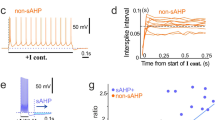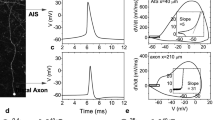Abstract
Voltage recordings from neostriatal projection neurons were obtained using in vitro intracellular techniques before and during K+-conductance blockade. Neurons were stained with the biocytin technique. Somatic surface area (A S) was determined by both whole-cell recordings in isolated somata and by measuring stained somata recorded in slices. Dendritic measurements were done in reconstructed neurons. Average determinations of dendritic (A D) and neuronal (A N) surface areas coincided with previously reported anatomical data. Thus: A S≈ 6.5 × 10–6 cm2; A D≈ 1.9 × 10–4 cm2; A N≈A D + A S≈ 2 × 10–4 cm2; A D/A S≈ 30. Measurements were done before and after superfusion with K+-conductance blockers (K+-blockers). Cells whose neuronal morphology was not obviously distorted by K+-blockade were chosen for the present study. Electrotonic transients were matched to a somatic shunt equivalent cylinder model adjusted with the generalized correction factor (F dga) that constrains the parameters for neuronal anatomy. Neuronal input resistance (R N; mean ± SEM) increased when it was corrected for somatic shunt, from 49 ± 2 MΩ (n = 80) to 179 ± 7 MΩ (n = 32). A difference was also obtained between the slowest time constant, τ0 = 16 ± 0.9 ms (n = 49), and the dendritic membrane time constant, τmD = 33 ± 1.6 ms (n = 36). When these electrophysiological measurements were used to calculate A N, the value obtained was similar to the anatomical measurements. Combining anatomical and electrophysiological data, somatic and dendritic input resistances were determined: R D = 182 ± 7 MΩ; R S (with shunt) = 74 ± 4 MΩ (n = 32). The generalized correction factor, F dga = 0.91 ± 0.007 (n = 10), implied a short effective electrotonic length for dendrites: L D = 0.46 ± 0.014 (n = 32). Saturating concentrations of the K+-blockers tetraethylammonium, Cs+, and Ba2+ increased R N and induced charging curves well fitted by single exponential functions in 56% of neostriatal neurons. Ba2+ greatly decreased the somatic shunt (n = 5): (R N = 216 ± 21 MΩ, τ0 = 46 ± 2 ms, R D = 239 ± 25 MΩ, and R S = 3.2 ± 0.5 GΩ), rendering values similar to those obtained with whole-cell recordings (e.g., R N≈ 198 MΩ, RS≈ 2.62 GΩ) (n = 52). Cs+ (n = 5) had less effect on the somatic shunt (R N = 115 ± 19 MΩ, τ0 = 49 ± 13 ms, R S = 161 ± 8 MΩ), although dendritic conductance was equally blocked (R D = 261 ± 16 MΩ). The Cs+-sensitive conductance exhibited inward rectifying properties not displayed by the Ba2+-sensitive conductance, suggesting that Cs+ preferentially acted upon inward rectifier conductances. In contrast, Ba2+ significantly acted upon linear conductances making up the somatic shunt. This suggests a differential action of different K+-blockers on the somato-dendritic membrane, implying a differential distribution of membrane conductances. Another action of K+-blockers, in about 40% of the cells, was to induce dye and probably electrical coupling between neighboring neurons.
Similar content being viewed by others
Author information
Authors and Affiliations
Additional information
Received: 30 April 1997 / Accepted: 14 October 1997
Rights and permissions
About this article
Cite this article
Reyes, A., Galarraga, E., Flores-Hernández, J. et al. Passive properties of neostriatal neurons during potassium conductance blockade. Exp Brain Res 120, 70–84 (1998). https://doi.org/10.1007/s002210050379
Issue Date:
DOI: https://doi.org/10.1007/s002210050379




